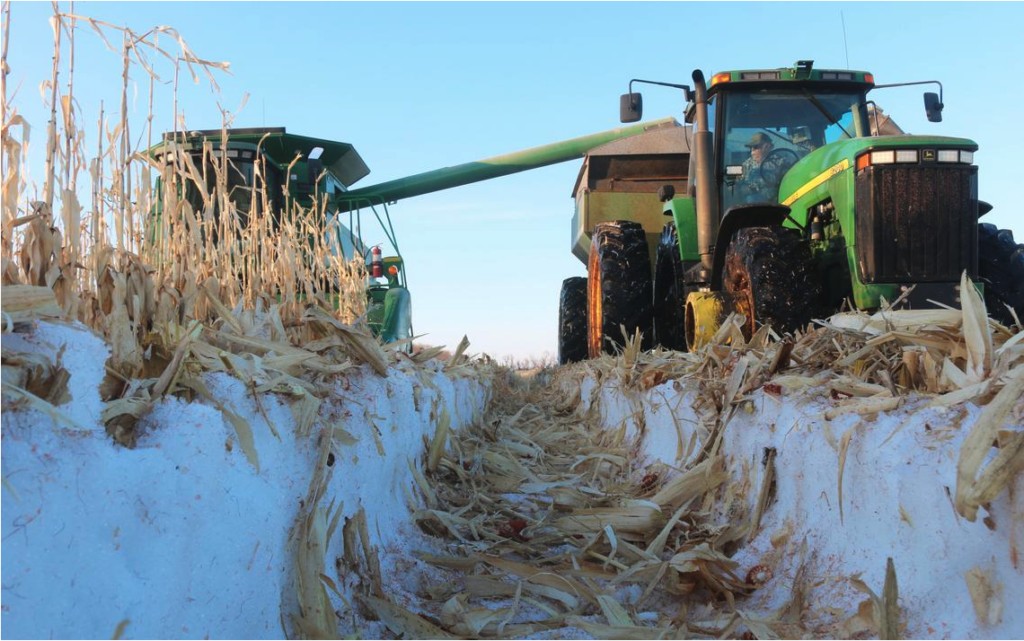Farmers Harvesting Corn in North Dakota Happy with Stand, Yield
Source: article by Mikkel Pates, (Grand Forks (ND) Herald
HORACE, N.D. – Larry Richard remembers when he used to listen to experts recommend farmers make heroic efforts to get it out of the field and not risk winter harvest losses.
“That was old school, when corn varieties weren’t as good as they are today,” Richard says, happily harvesting corn in the snow near Fargo, N.D.
Nearly half of North Dakota’s corn crop was left in the field last fall.
Richard, 66, had 960 corn acres. Last fall, he harvested 100 acres to fill a contract but started harvesting the balance of 860 acres Tuesday, March 3. He was motoring through 17- to 18-inch snowbanks in a 75-acre field. He decided to wait a few days and let it melt down some more.
He’s not so worried about any turn in the weather.
Larry Richard, 66, of Horace, N.D., is harvesting corn in the snow for the seventh time in his 40 years of farming. Photo taken March 3, 2020, north of Fargo, N.D. Mikkel Pates / Agweek
“If it snows, we just wait for it to melt back down,” he says. “Today, (corn) stands like a fence post. Very little of that is tipping over. You don’t drop any ears to the ground. It’s almost nothing.”
40th harvest
Richard, 66, started farming in 1980, so this is his 40th harvest. The 2019 crop year was one of his toughest so far, with flooding in the spring, raining steadily during the summer, with poor sunlight quality, so the crop didn’t mature.
“This is the seventh time I’ve left corn out over winter,” he says.
The last time was in 2017 – a deliberate move when he ran out of storage space and he figured the price was going to be better in the spring. “We combined that and hauled it right to the elevator and it was 15% moisture and excellent quality,” Richard says, “The test weight was at 57 to 58 pounds (per bushel test weight).”
Richard says he wondered about harvest loss in the spring of 2018 after hearing some North Dakota State University Extension advice on that topic. He says he he walked a mile of the field and found 26 cobs of corn. That worked out to .05% yield loss on cobs that fell to the ground.
“That’s nothing,” he says.
Little research
Ken Hellevang, an NDSU agricultural engineer, says there is little research that helps farmers weigh the practicality of delaying harvest over the winter. “We’re gaining a lot of experience,” Hellevang says.
“If we’ve got a year with strong stalks, and good ear attachment to those stalks, in our northern climate, we’ve had pretty good success leaving it in the field,” he said.
Some farmers make the decision year-to-year. Some will “push” on the stalks and realize they don’t have the strength. “It really is almost a field by field determination,” he said.
There must be “room between the cob and the snowbank,” he said. This year, Hellevang has heard good reports on that. The problem comes when snow makes it into the combine, into the hopper and the bin.
“That can cause trouble in storage,” he said.
If snow gets into the combine and melts, the combine must be dried out.
Combine carrying well
Normally, Richard waits until the snow melts to about 12 inches or less, so he can get underneath the cobs better. Richard uses a John Deere 9650 STS combine, which came with the rear-wheel-assist drive, which he says is a must. “It helps you turn and keeps you on the row,” he says. “I’ve got duals and it’s carrying fine.”
He wasn’t worried about getting stuck on frozen, heavy clay soil this field is on. He acknowledges conditions might be dicier on more loamy soil types, or in prairie pothole country.
“When it freezes, it carries really well,” he says, of his fields. “During the fall, when it’s wet, we’re going to be making ruts and every time I’ve combined in the spring, I’ve had zero ruts in the field. It really works well.”
Last fall, the corn averaged 23% to 28% moisture. When he tried drying it, the quality coming out of the dryer was “terrible.” The test weight was 48 pounds per bushel – a quality that caused steep, 40-cent per bushel discounts at elevators that would take it. Not everybody did.
Standard, No. 2 yellow corn is 56 pounds per bushel.
“Right now it looks really nice,” he said, as he was combing on March 3. “No cracking (of kernels). The test weight had increased to 52.6 pounds.
At the same time, the moisture content had gone down to 17%. “I’ll continue to dry it in the bin with air drying,” he says, expecting to bring it to 14% to 15% moisture, for storage.
The worst thing he anticipates is loading trucks on the road, when he expected to resume harvest, Monday, March 9. He urges other farmers to think positively as they go after corn in the snow. “Go get it! Hammer it out!” he says.
Source: AgriMarketing
